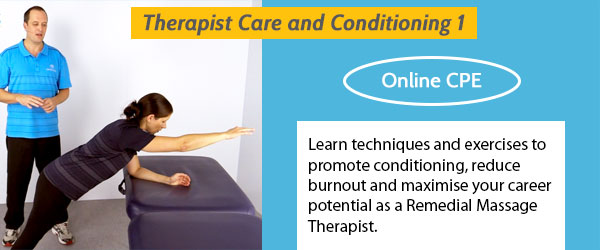We are entering strange times of change in the realm of musculoskeletal and massage therapies. Once upon a time, the dominant model of understanding pain and the human body was mechnical – now it is changing. We should now also look at how the individual relates to pain by assessing the client’s overall health picture, including their relative safety within their lifestyle activities and work environment. Instead of aligning “structure” in beautiful symmetry, we instead look at how the joint “feels” and “moves.” Let’s ponder this thought for Massage Therapists – how about focussing more on what is “right” rather than what is wrong?
The Legacy of a Largely Biomechanical Model
So much of our training in bodywork and massage has been around identifying what is wrong with a client’s body and we take great pride in telling a client all their physical flaws that we have carefully assessed. But at what cost? What is the impact of informing someone that one side of their body moves a few millimeters less than the other side? Is informing a client about small (often minute, barely palpable) “dysfunctions” actually harmless, or is that going to be useful information? Or could it be that this style of “client education” is leading to a fragile sense of self? Are the therapist’s good intentions instilling a belief that a client’s body is inherently flawed? Are we suggesting in order to be pain free, that a client has to be on an internal vigil to look out for some imperceptible movement, to stop something from going “out” or everything is going to fall apart, again?
Professor Peter O’Sullivan discusses some of the myths about back pain which negatively impact on the perception and treatment of back pain.
So Where Does Biomechanics Fit In?
Let’s not throw the baby out with the bathwater. Any biomechanical training that a therapist has learnt, is invaluable education. Knowing what good movement should look like and being able to spot differences that are very obvious are important skills in client care. It is generally accepted that pain will noticeably impact human movement, so knowing what is normal for your client and being able to identify noticeable changes is going to be essential for good care and treatment.
To be clear, if your client is focused on performing specific skill execution, for example, in sport, outdoor activities, or work related tasks, then you can definitely use biomechanics to determine whether you are optimising good body performance. But this is different to pain management, this is functional performance. Perhaps we made a mistake linking biomechanics directly to pain, but we certainly didn’t make an error linking biomechanics with human performance.
So, when working with a client, ask yourself if you are working on “function” or “pain” because these can be two completely separate goals for treatment. Often we may have to accept the client will have pain, but we can at least aim to get them functioning as well as we can to achieve their goals. This is when a biomechanical analysis is best used, when improved function is the goal.
Join the Bright Health Training newsletter
The Good News…. Non-Specific Exercise Works
With generations of therapists spending a lot of time correcting the biomechanics of movement to treat pain, this in many cases become the status quo of corrective exercise. Pilates is a great example, where movement must be made precise to treat pain. The good news is that we don’t have to be that precise. Exercise in general (strength, aerobic and hydrotherapy as examples) has been shown to be as effective as “corrective” methods when treating chronic pain.
Many musculoskeletal complaints will resolve with targeted exercise protocols (such as tendinopathy), but for anyone with chronic pain, any form of exercise can be as potentially effective as any other. Specific forms of exercise that are trained around “correcting” movement are still effective, just maybe not more effective than other methods.
This again highlights the importance of determining what are the drivers behind a client’s loss of function or pain? Is the pain driven by local tissue or more central factors? Is there a definite, detectable change in tissue, such as palpable swelling, decreased range of motion or noticeable thickening of tendons? If there is, then that is a pretty clear indicator that localised approaches could work well. Starting a simple hypertrophy program for tendon management is probably the best way to manage this condition and as such, should be targeted at the site of tendon changes.
But if someone is experiencing pain in an apparently “non-injured tissue” we need to consider that there is at least a significant component to their pain that is not caused by the state of their tissues and the CNS(central nervous system) may be the true cause of their pain.
Tissue Tension as an Indicator of Safety or Threat?
But what about tension? Good old fashioned, “gee whiz, you feel tight?”
I think we generally agree tight tissue is a thing and manual therapy can trigger a relaxation effect that can include increased range of motion. But is this truly the cause of decreases in pain that are reported through manual therapies and the more mobility targeted methods of exercise? Is it because the tissues are now softer and there is less stimulation to mechanoreceptors in the fascia, or could it be that a neurological refreshing of a painful area of the brain has occurred?
The simple answer is, that pain will always be mediated by central factors in the brain, but what exact role local tissue tension has in pain is still unclear. That being said, any reliable sensation such as tissue tightness/tension and restricted range of motion can add to a sense of threat to the body, and threat is something that has been linked to increased pain levels.
Which Model of Care is Best?
Many of the changes that occur to local tissues in manual therapies such as massage and mobility methods like stretching, are most likely to have the best results when targeted at function or conditions clearly affecting local tissue. But approaches that are targeted at developing “whole person” function are likely to be the best when managing chronic pain.
How much of each approach you use should be based on your client assessment. If it is clear a client has local tissue damage such as inflammation or indications of tendinopathy, (tendon pain or thickening) then approaches targeting the local tissues are best employed. The same could be said if the pain has occurred in the last few weeks or even months.
But if a client has had pain for more than 3 months and there aren’t obvious, visible signs of tissue damage, then consider looking at lifestyle factors – workload, training load and psychological and social stress, in your assessment. This may have more of an impact on their pain than their range of motion. Whilst massage and other methods may provide short-term pain relief, the effects may not last very long. The therapist could be missing an opportunity to address the real cause of their client’s pain, if they only focus on one model – biomechanics.
So in the name of client centered care, let’s keep an open mind to more than one approach!


